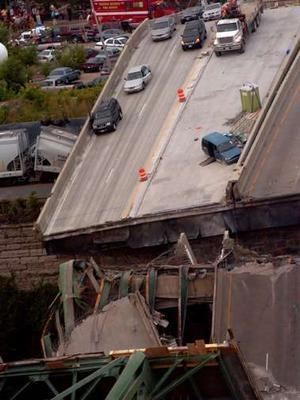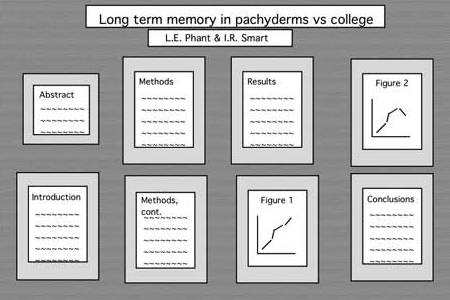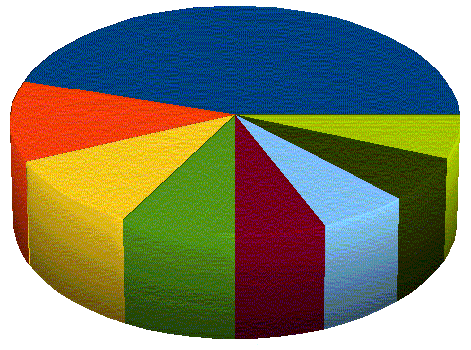
Menu:
Behrooz Parhami's ECE 257A Course Page for Fall 2018

Fault-Tolerant Computing
Page last updated on 2018 December 14
Enrollment code: 54452
Prerequisite: ECE 154 (or equivalent)
Class meetings: MW 10:00-11:30, Girvetz 2127
Instructor: Professor Behrooz Parhami
Open office hours: M 12:00-2:00, W 1:00-2:00; HFH 5155
Course announcements: Listed in reverse chronological order
Course calendar: Lecture, homework, and exam schedules
Homework assignments: Four assignments, worth a total of 30%
Exams: Midterm, worth 30%; Final, worth 40% (both open-book)
Research paper: Not required for fall 2018
Research paper guidlines: Brief guide to format and contents
Poster presentation tips: Brief guide to format and structure
Policy on academic integrity: Please read very carefully
Grades: Statistics for homework and exam grades
References: Textbook and other sources (Textbook's web page)
Lecture slides: Via the textbook's Web page
Miscellaneous information: Motivation, catalog entry, history
Course Announcements

2018/12/14: The fall 2018 offering of ECE 257A is officially over and course grades have been reported to the Registrar. Wishing you joyous holidays and a happy New Year!
2018/12/08: I have posted a corrected solution under HW4 in the homework area below.
2018/12/05: [FYI, due to our discussion of professional ethics in class today.] ACM 2018 Code of Ethics and Professional Conduct: Association for Computing Machinery's previous code, adopted in 1992, is being revised this year. The third draft of the new code is now available for previewing and comments.
2018/12/03: As mentioned today in class, I will hold additional office hours on Friday 12/07 to answer any last-minute questions you might have in preparation for our open-everything final exam of Monday 12/10, 8:30-11:00 AM. However, I am changing the announced 12/07 extra office hours to 2:00-4:00 PM, because I had overlooked another commitment.
2018/11/25: Homework 4, the last one for the course, has been posted to the homework area below.
2018/11/13: Homework 3 has been posted to the homework area below. Tomorrow's midterm exam will be open-everything (book, notes, computer, Internet). I will be in my office from 2:00 to 4:00 this afternoon for any last-minute questions.
2018/11/08: Given that my only remaining office hours before the midterm fall on the 11/12 Veterans' Day holiday, I have added extra office hours on Tuesday, 11/13, 2:00-4:00 PM, for any last minute questions.
2018/10/21: Homework 2 has been posted to the homework area below.
2018/10/05: Homework 1 has been posted to the homework area below. Please follow the submission instructions provided at the beginning of the homework area. I have updated this course page to reflect the fact that we will have a final exam (on M 12/10, 8:00-11:00 AM), and not a research paper.
2018/09/30: Chapters and slides for the first part of the textbook have been updated. As of today, the course enrollment stands at 24. I may decide to restore the final exam and not require a research paper, given the class size. The decision will be made by mid October.
2018/06/22: Welcome to the ECE 257A web page for fall 2018. Our classroom has 30 seats, with 10 students enrolled at this time. I plan to update the lecture slides and textbook chapters over the summer, with each revised chapter becoming available shortly before discussion in class. I won't hold scheduled office hours during summer, but you can contact me via e-mail to ask questions about the course or to set up a meeting.
Course Calendar

Course lectures, homework assignments, and exams, have been scheduled as follows. Once finalized in late summer, this schedule will be strictly observed. In particular, no extension is possible for homework due dates. Please begin work on your assignments early. Each lecture corresponds to topics in 1-2 chapters of the instructor's forthcoming textbook on dependable computing. Chapter numbers are provided in parentheses, after day & date.
Day & Date (book chapters) Lecture topic [Homework posted/due] {Special notes}
M 10/01 (0-1) Background and motivation
W 10/03 (1-2) Dependability attributes
M 10/08 (3) Combinational modeling [HW1 posted, chs. 1-4]
W 10/10 (4) State-space modeling
M 10/15 (5, 7) Defect avoidance; Shielding and hardening
W 10/17 (6, 8) Defect circumvention; Yield enhancement [HW1 due]
M 10/22 (9, 11) Fault testing; Design for testability [HW2 posted, chs. 5-12]
W 10/24 (10, 12) Fault masking; Replication with voting
M 10/29 No lecture (instructor away at a conference)
W 10/31 No lecture (instructor away at a conference) [HW2 due]
M 11/05 (13, 15) Error detection; Self-checking modules
W 11/07 (14, 16) Error correction; Redundant disk arrays
M 11/12 No lecture (Veterans' Day observed)
W 11/14 (1-12) Midterm exam, open-book/notes, 10:00-11:45 [HW3 posted, chs. 13-20]
M 11/19 (17, 19) Malfunction diagnosis; Standby redundancy
W 11/21 (18, 20) Malfunction tolerance; Robust parallel processing
M 11/26 (21, 23) Degradation allowance; Resilient algorithms [HW3 due] [HW4 posted, chs. 21-28]
W 11/28 (22, 24) Degradation management; Software redundancy
M 12/03 (25, 27) Failure confinement; Agreement and adjudication {Instructor and course evaluations}
W 12/05 (26, 28) Failure recovery; Fail-safe systems [HW4 due]
M 12/10 Final exam {Will be held in our regular classroom from 8:00 to 11:00 AM}
W 12/19 {Course grades due by midnight}
Homework Assignments

-Turn in your solutions as a PDF file attached to an e-mail sent by the due date/time.
-Because solutions will be handed out on the due date, no extension can be granted.
-Include your name, course name, and assignment number at the top of the first page.
-If homework is handwritten and scanned, make sure that the PDF is clean and legible.
-Although some cooperation is permitted, direct copying will have severe consequences.
Homework 1: Dependability and its modeling (chs. 1-4, due W 2018/10/17, 10:00 AM)
Do the following problems from the textbook or defined below: 1.7, 1.24, 2.26, 3.10, 4.1
1.24 Risks of infrastructure deterioration In September 2018, gas explosions rocked a vast area in northeastern Massachusetts, leading to the loss of one life, many injuries, and destruction of property. Investigations revealed that just before the explosions, pipe pressure was 12 times higher than the safe limit. Using Internet sources, write a one-page report on this incident, focusing on how/why pressure monitors, automatic shut-off mechanisms, and human oversight failed to prevent the disaster.
2.26 Risks of trusting the physics of sensors Many safety-critical systems collect data from sensors for use in making their decisions. Read the paper [Fu18] and write a one-page summary for it, focusing on safety challenges that are unique to sensors (as opposed to general risks associated with trusting technology).
[Fu18] Fu, K. and W. Xu, "Risks of Trusting the Physics of Sensors," Communications of the ACM, Vol. 61, No. 2, pp. 20-23, February 2018.
Homework 2: Defects and faults (chs. 5-12, due W 2018/10/31, 10:00 AM)
Do the following problems from the textbook: 5.7, 8.3, 9.4, 10.5, 11.1, 12.2
Homework 3: Errors and malfunctions (chs. 13-20, due M 2018/11/26, 10:00 AM)
Do the following problems from the textbook: 13.12, 14.7, 16.4, 17.4, 20.4
Homework 4: Degradations and failures (chs. 21-28, due W 2018/12/05, 10:00 AM)
Do the following problems from the textbook: 21.3, 23.1, 24.9, 25.1, 27.7
Corrected solution to Problem 25.1: Let's keep the failure transition from State 2 to State 1 with its current rate of 2λ and add a transition from State 2 to State 0 with the unknown rate δ. The new failure rate of the system (probability of transitioning into State 2) is the old (approximate) failure rate of 2λ^2/μ (derived in Example 25.valid) plus the added failure rate δ. Equating the overall failure rate 2λ^2/μ + δ with the observed effective failure rate of 1/1371 yields δ = 0.000,73/hour, which is more than 18 times a disk pair's claimed failure rate of 2λ = 0.000,04/hour. Note that the inverse of 0.000,73/hour is roughly 1370 hours, so the system's MTTF is dictated almost entirely by the new transition. If we were to adjust the model without adding the new transition from State 2 to State 0, the disk failure rate must be set to λ = 0.008,54, that is 427 times its claimed value. [Note: Part a of Example 25.valid contains a calculation error.]
Sample Exams and Study Guide

The following sample exam problems are meant to indicate the types and levels of problems, rather than the coverage (which is outlined in the course calendar).
Students are responsible for all sections and topics in the textbook and class handouts that are not explicitly excluded in the study guide that follows each sample exam, even if the material was not covered in class lectures.
Sample Midterm Exam (105 minutes)
Problems 3.12, 4.4, 9.4, and 12.1 from the textbook.
Midterm Exam Study Guide
Study Chapters 1-12 and review the problems in homework assignments 1-2. The following textbook sections are excluded: 6.6, 7.6, 8.6, 9.4, 9.6, 11.6
Sample Final Exam (120 minutes)
Problems 15.5, 17.1, 21.2, and 27.3 from the textbook.
Final Exam Study Guide
Study Chapters 13-28 and review the problems in homework assignments 3-4. The following textbook sections are excluded: 13.6, 14.6
Research Paper and Presentation

[This section has not yet been updated for fall 2018]
Each student will review a subfield of dependable computing or do original research on a selected and approved topic. A preliminary list of research topics is provided below (new topics, and new references for the current topics, may be added later). However, students should feel free to propose their own topics for approval. To propose a topic, send via e-mail a one-page narrative, including 2-3 key references, to the instructor.
A publishable report earns an "A" for the course, regardless of homework and midterm grades. See the course calendar for schedule and due dates and Research Paper Guidlines for formatting tips.
This year's suggested research topics for ECE 257A are built around the theme "Robustness of Interconnection networks." You can get started on each topic by taking a look at the following two common references, plus one topic-specific reference that is provided further down on this page. The two common references are:
[Parh10] Parhami, B., "Robustness Attributes of Interconnection Networks for Parallel Processing," Keynote Lecture at the First Int'l Supercomputing Conf., Guadalajara, Mexico, March 2010. {PPT and PDF slides are available from B. Parhami's Publications Web page; see publication [262].}
[Sall12] Salles, R. M. and D. A. Marion Jr., "Strategies and Metric for Resilience in Computer Networks," Computer J., Vol. 55, No. 6, pp. 728-739, June 2012.
1. Effects of Missing Nodes on Network Diameter and Average Distance (Assigned to: Adrian Fiorito)
[Kris87] Krishnamoorthy, M.S. and B. Krishnamurthy, "Fault Diameter of Interconnection Networks," Computers & Mathematics with Applications, Vol. 13, Nos. 5/6, pp. 577-582, 1987.
2. Effects of Missing Links on Network Diameter and Average Distance (Assigned to: TBD)
[Kris87] Krishnamoorthy, M.S. and B. Krishnamurthy, "Fault Diameter of Interconnection Networks," Computers & Mathematics with Applications, Vol. 13, Nos. 5/6, pp. 577-582, 1987.
3. Synthesis of Interconnection Networks with Maximal Fault Tolerance (Assigned to: TBD)
[Chen09] W. Chen, W. J. Xiao, and B. Parhami, "Swapped (OTIS) Networks Built of Connected Basis Networks are Maximally Fault Tolerant," IEEE Trans. Parallel and Distributed Systems, Vol. 20, pp. 361-366, March 2009.
4. Adaptive Schemes for Point-to-Point Communication in Networks (Assigned to: Xuan Wang)
[Ngai91] Ngai, J. Y. and C. L. Seitz, "A Framework for Adaptive Routing in Multicomputer Networks," Computer Architecture News, Vol. 19, No. 1, pp. 6-14, March 1991.
5. Adaptive Schemes for Collective Communication in Networks (Assigned to: Prashansa Mukim)
[Pand95] Panda, D. K., "Issues in Designing Efficient and Practical Algorithms for Collective Communication on Wormhole-Routed Systems," Proc. Int'l Conf. Parallel Processing Workshop on Challenges for Parallel Processing, 1995, pp. 8-15.
6. Deadlocks in Adaptive Routing and How to Avoid or Detect Them (Assigned to: Fengqiao Sang)
[Dall93] Dally, W. J. and H. Aoki, "Deadlock-Free Adaptive Routing in Multicomputer Networks Using Virtual Channels," IEEE Trans. Parallel and Distributed Systems, Vol. 4, No. 4, pp. 466-475, April 1993.
7. Diagnosability of Regular Degree-d Interconnection Networks (Assigned to: Sixin Tao)
[Chan05] Chang, G.-Y., G. J. Chang, and G.-H. Chen, "Diagnosabilities of Regular Networks," IEEE Trans. Parallel and Distributed Systems, Vol. 16, No. 4, pp. 314-323, April 2005
8. Diagnosability of Hierarchical or Multilevel Interconnection Networks (Assigned to: Nan Wu)
[Xu09] Xu, M., K. Thulasiraman, and X.-D. Hu, "Conditional Diagnosability of Matching Composition Networks Under the PMC Model," IEEE Trans. Circuits and Systems II, Vol. 56, No. 11, pp. 875-879, November 2009.
9. Synthesis of Interconnection Networks with Maximal Diagnosability (Assigned to: Yiming Gan)
[Chan05] Chang, G.-Y., G. J. Chang, and G.-H. Chen, "Diagnosabilities of Regular Networks," IEEE Trans. Parallel and Distributed Systems, Vol. 16, No. 4, pp. 314-323, April 2005
Topics outside the main theme for the quarter
a. Reasoning Under Uncertainly, with Applications to Dependable Computing (Assigned to: TBD)
[IJAR16] Int'l J. Approximate Reasoning, Vol. 71, pp. 1-62, December 2016 (Five review articles on 40 years of Dempster-Shafer Theory)
b. Probabilistic Analysis of Program Correctness Under Soft Errors (Assigned to: TBD)
[Carb16] Carbin, M., S. Misailovic, and M. C. Rinard, "Verifying Quantitative Reliability for Programs that Execute on Unreliable Hardware," Communications of the ACM, Vol. 59, No. 8, pp. 83-91, August 2016.
c. Effects of Temporal Resistance-State Variation on ReRAM Reliability (Proposed by: Abanti Basak)
[Ref 1] "Modeling Framework for Cross-Point Resistive Memory Design Emphasizing Reliability and Variability Issues"
d. Computation-Oriented Fault Tolerance Schemes for RRAM-Based Systems (Proposed by: Wenqin Huangfu)
[Chen15] Chen, C.-Y., et al., "RRAM Defect Modeling and Failure Analysis Based on March Test and a Novel Squeeze-Search Scheme," IEEE Trans. Computers, Vol. 64, No. 1, pp. 180-190, January 2015.
Poster Presentation Tips

Here are some guidelines for preparing your research poster. The idea of the poster is to present your research results and conclusions thus far, get oral feedback during the session from the instructor and your peers, and to provide the instructor with something to comment on before your final report is due. Please send a PDF copy of the poster via e-mail by midnight on the poster presentation day.
Posters prepared for conferences must be colorful and eye-catching, as they are typically competing with dozens of other posters for the attendees' attention. Here is an example of a conference poster. Such posters are often mounted on a colored cardboard base, even if the pages themselves are standard PowerPoint slides. In our case, you should aim for a "plain" poster (loose sheets, to be taped to the wall in our classroom) that conveys your message in a simple and direct way. Eight to 10 pages, each resembling a PowerPoint slide, would be an appropriate goal. You can organize the pages into 2 x 4 (2 columns, 4 rows), 2 x 5, or 3 x 3 array on the wall. The top two of these might contain the project title, your name, course name and number, and a very short (50-word) abstract. The final two can perhaps contain your conclusions and directions for further work (including work that does not appear in the poster, but will be included in your research report). The rest will contain brief description of ideas, with emphasis on diagrams, graphs, tables, and the like, rather than text which is very difficult to absorb for a visitor in a very limited time span.
Grade Statistics

All grades listed are in percent, unless otherwise noted.
HW1 grades (letter): Range = [B, A], Mean = 3.66, Median = A-
HW2 grades (letter): Range = [B, A], Mean = 3.78, Median = A-
HW3 grades (letter): Range = [B-, A], Mean = 3.11, Median = B
HW4 grades (letter): Range = [B, A-], Mean = 3.47, Median = A-
Overall homework grades: Range = [65, 96], Mean = 87, Median = 88
Midterm exam grades: Range = [41, 100], Mean = 73, Median = 73
Final exam grades: Range = [45, 83], Mean = 64, Median = 67
Course grades (letter): Range = [B, A+], Mean = 3.61, Median = A-
References

Required text: B. Parhami, Dependable Computing: A Multilevel Approach, chapters will be posted as they are updated. Please visit the textbook's web page for general information. Lecture slides are also available there.
Some useful books (not required):
Koren/Krishna, Fault-Tolerant Systems, Morgan Kaufmann, 2007 (ISBN 0-12-088525-5)
Shooman, Reliability of Computer Systems and Networks, Wiley, 2002 (ISBN 0-471-29342-3)
Siewiorek/Swarz, Reliable Computer Systems, Digital Press, 1992 (ISBN 1-55558-075-0)
Johnson, Design and Analysis of Fault-Tolerant Digital Systems, Addison Wesley, 1989 (ISBN 0-201-07570-9)
Research resources:
Proc. IEEE/IFIP Int'l Conf. Dependable Systems and Networks (DSN), formerly known as Fault-Tolerant Computing Symp. (FTCS), annual, since 1971.
IEEE Trans. Dependable and Secure Computing, published since 2004
IEEE Trans. Reliability, published since 1955
IEEE Trans. Computers, published since 1952
UCSB library's electronic journals, collections, and other resources
Miscellaneous Information
Motivation: Dependability concerns are integral parts of engineering design. Ideally, we would like our computer systems to be perfect, always yielding timely and correct results. However, just as bridges collapse and airplanes crash occasionally, so too computer hardware and software cannot be made totally immune to unpredictable behavior. Despite great strides in component reliability and programming methodology, the exponentially increasing complexity of integrated circuits and software systems makes the design of prefect computer systems nearly impossible. In this course, we study the causes of computer system failures (impairments to dependability), techniques for ensuring correct and timely computations despite such impairments, and tools for evaluating the quality of proposed or implemented solutions.
Catalog entry: 257A. Fault-Tolerant Computing. (4) PARHAMI. Prerequisites: ECE 154. Lecture, 3 hours. Basic concepts of dependable computing. Reliability of nonredundant and redundant systems. Dealing with circuit-level defects. Logic-level fault testing and tolerance. Error detection and correction. Diagnosis and reconfiguration for system-level malfunctions. Degradation management. Failure modeling and risk assessment.
History: Professor Parhami took over the teaching of ECE 257A in the fall quarter of 1998. Previously, the course had been taught primarily by Dr. John Kelly, who instituted the two-course sequence ECE 257A/B, the first covering general topics and the second (now discontinued) devoted to his research focus on software fault tolerance. Borrowing from his experience in teaching dependable computing at other universities and based on an extensive survey of the field that he published in 1994, Professor Parhami oriented the course toward an original multilevel view of impairments to computer system dependability and techniques for avoiding or tolerating them. The levels of this models, in increasing order of abstraction, are: defects, faults, errors, malfunctions, degradations, and failures. A textbook based on this multilevel model of dependable computing is in preparation.
Offering of ECE 257A in fall 2016 (PDF file)
Offering of ECE 257A in fall 2015 (PDF file)
Offering of ECE 257A in winter 2015 (PDF file)
Offering of ECE 257A in fall 2013 (PDF file)
Offering of ECE 257A in fall 2012 (PDF file)
Offering of ECE 257A in fall 2009 (PDF file)
Offering of ECE 257A in fall 2007 (PDF file)
Offerings of ECE 257A in 1998 and 2006 (PDF file)